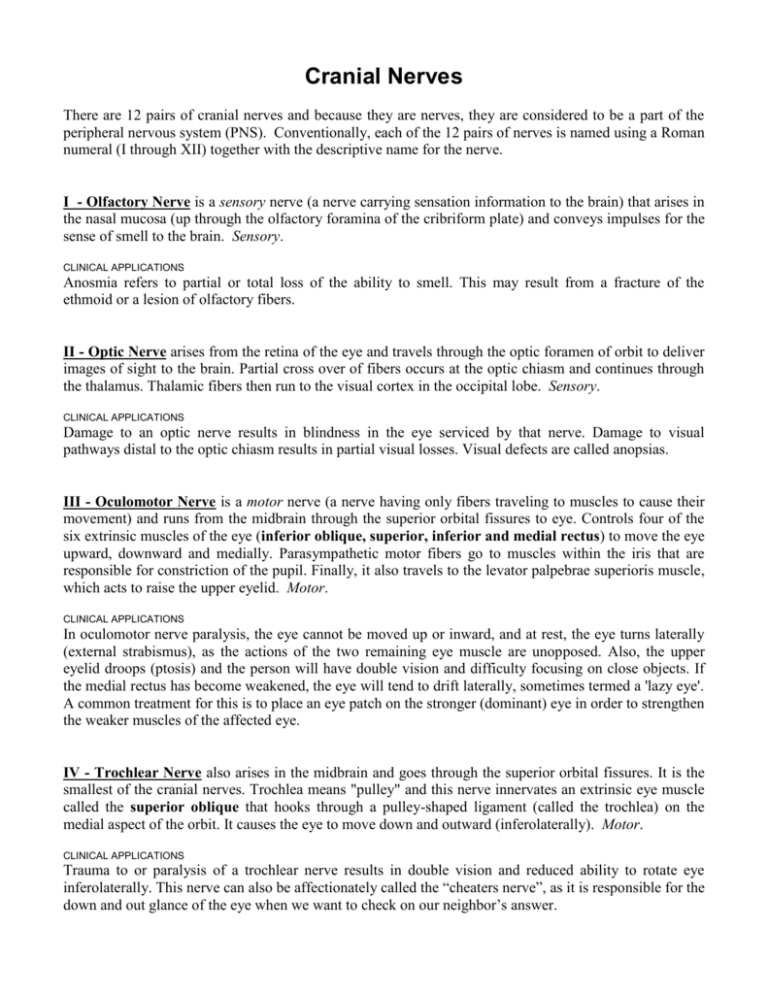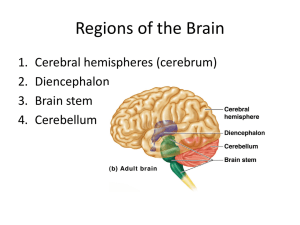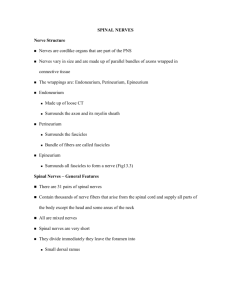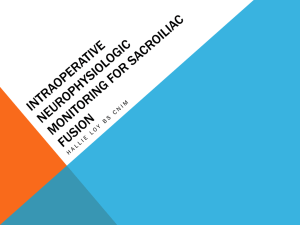Cranial Nerves Lecture
advertisement

Cranial Nerves There are 12 pairs of cranial nerves and because they are nerves, they are considered to be a part of the peripheral nervous system (PNS). Conventionally, each of the 12 pairs of nerves is named using a Roman numeral (I through XII) together with the descriptive name for the nerve. I - Olfactory Nerve is a sensory nerve (a nerve carrying sensation information to the brain) that arises in the nasal mucosa (up through the olfactory foramina of the cribriform plate) and conveys impulses for the sense of smell to the brain. Sensory. CLINICAL APPLICATIONS Anosmia refers to partial or total loss of the ability to smell. This may result from a fracture of the ethmoid or a lesion of olfactory fibers. II - Optic Nerve arises from the retina of the eye and travels through the optic foramen of orbit to deliver images of sight to the brain. Partial cross over of fibers occurs at the optic chiasm and continues through the thalamus. Thalamic fibers then run to the visual cortex in the occipital lobe. Sensory. CLINICAL APPLICATIONS Damage to an optic nerve results in blindness in the eye serviced by that nerve. Damage to visual pathways distal to the optic chiasm results in partial visual losses. Visual defects are called anopsias. III - Oculomotor Nerve is a motor nerve (a nerve having only fibers traveling to muscles to cause their movement) and runs from the midbrain through the superior orbital fissures to eye. Controls four of the six extrinsic muscles of the eye (inferior oblique, superior, inferior and medial rectus) to move the eye upward, downward and medially. Parasympathetic motor fibers go to muscles within the iris that are responsible for constriction of the pupil. Finally, it also travels to the levator palpebrae superioris muscle, which acts to raise the upper eyelid. Motor. CLINICAL APPLICATIONS In oculomotor nerve paralysis, the eye cannot be moved up or inward, and at rest, the eye turns laterally (external strabismus), as the actions of the two remaining eye muscle are unopposed. Also, the upper eyelid droops (ptosis) and the person will have double vision and difficulty focusing on close objects. If the medial rectus has become weakened, the eye will tend to drift laterally, sometimes termed a 'lazy eye'. A common treatment for this is to place an eye patch on the stronger (dominant) eye in order to strengthen the weaker muscles of the affected eye. IV - Trochlear Nerve also arises in the midbrain and goes through the superior orbital fissures. It is the smallest of the cranial nerves. Trochlea means "pulley" and this nerve innervates an extrinsic eye muscle called the superior oblique that hooks through a pulley-shaped ligament (called the trochlea) on the medial aspect of the orbit. It causes the eye to move down and outward (inferolaterally). Motor. CLINICAL APPLICATIONS Trauma to or paralysis of a trochlear nerve results in double vision and reduced ability to rotate eye inferolaterally. This nerve can also be affectionately called the “cheaters nerve”, as it is responsible for the down and out glance of the eye when we want to check on our neighbor’s answer. 2 V - Trigeminal Nerve is a mixed nerve (a nerve having both sensory and motor fibers), it arises within the Pons and travels to the jaw's muscles to power chewing. The nerve also contains fibers bringing sensation from the face to the Pons. It is the largest of the cranial nerves and forms three divisions: Opthalmic division (V1) - from skin of anterior scalp, upper eyelid, nose, nasal cavity mucosa and lacrimal gland through superior orbital fissure. Maxillary division (V2) - from lower eyelid, palate, upper teeth, skin of cheek and upper lip through the foramen rotundum. Mandibular division (V3) - from anterior tongue, lower teeth, skin of chin, temporal region of scalp through the foramen ovale. Dentist desensitize upper and lower jaws by injecting local anesthetic into alveolar branches of maxillary and mandibular division respectively. Mixed or Both. CLINICAL APPLICATIONS Inflammation of the trigeminal nerve can cause tic douloureux or trigeminal neuralgia. This condition causes excruciating pain that only lasts for a few seconds to minutes but occurs relentlessly. The actual cause is unknown but may be due to pressure on the trigeminal nerve root. Sensory stimulus like brushing the teeth or air hitting the face can trigger an episode. Some respond to analgesics but severe cases may require cauterization, poisoning or severing of nerve proximal to trigeminal ganglion. VI - Abducens Nerve fibers leave the inferior Pons and enter the orbit via the superior orbital fissure (along with the oculomotor III and trochlear IV nerves), going to the extrinsic eye muscle the lateral rectus. The lateral rectus is responsible for rotating the eye outward (laterally). The nerve is so named because it abducts the eyeball (turns the eye laterally, away from midline). Motor. CLINICAL APPLICATIONS In abducens nerve paralysis, the eye cannot be moved laterally; at rest, the affected eyeball turns medially (internal strabismus), giving a person a 'cross-eyed' condition. VII - Facial Nerve arising from the Pons and innervates (gives nerve supply to) the muscles of facial expression, the eyelids, as well as some of the muscles which assists speech and mastication. It also is involved in the control of saliva secretion. The nerve also contains fibers that bring taste sensation from anterior two-thirds of tongue to the brainstem. Mixed or Both. CLINICAL APPLICATIONS Bell's palsy is caused by the herpes simplex virus and is characterized by paralysis of facial muscles on the affected side and partial loss of taste sensation. The virus produces an inflammation of the facial nerve and can occur rapidly (often overnight). Symptoms include lower eyelid drooping, corner of mouth sagging (difficulty in eating and speaking), constant tear dripping and an inability to completely close eye. Can resolve spontaneously without treatment. VIII - Vestibulocochlear Nerve arises in the inner ear and passes through the internal auditory meatus to enter brain stem at the Pons. It is really two nerves (the vestibular n. and the cochlear n.) housed together. The vestibular component conveys equilibrium and position sense and coordinates movement of head and neck. The cochlear component coveys sound waves and is responsible for hearing. Sensory. CLINICAL APPLICATIONS Lesions of the cochlear nerve or cochlear receptors result in central or nerve deafness, whereas damage to the vestibular division produces disturbances associated with equilibrium, such as dizziness, rapid involuntary eye movements, loss of balance, nausea and vomiting. 3 IX - Glossopharyngeal Nerve brings sensation from the pharynx (back of the throat), senses blood pressure and O2 and CO2 content from the carotid artery, delivers taste sensation from posterior onethird of tongue to the Medulla. Parasympathetic motor fibers activate parotid salivary gland. It also sends motor nerve fibers to the to elevate the pharynx when swallowing. Mixed or Both. CLINICAL APPLICATIONS Injury or inflammation to the glossopharyngeal nerves impairs swallowing and taste on the posterior third of the tongue, particularly for sour and bitter tasting substances. X - The Vagus Nerve is the only cranial nerve to extend beyond the neck region. Its motor fibers come from the medulla through the jugular foramen and descend to the neck, thorax and abdomen. Involved in swallowing, controlling muscle of larynx; parasympathetic motor fibers regulate cardiac, pulmonary, and part of gastrointestinal activities. It brings sensation from the gastrointestinal tract back to the medulla as well as information for blood pressure (carotid sinus) and chemistry (carotid and aortic bodies). Mixed CLINICAL APPLICATIONS Vagus nerve paralysis can lead to hoarseness or loss of voice; other symptoms include difficulty swallowing, impaired digestive system motility. Total destruction of both vagus nerves is incompatible with life, as the parasympathetic fibers are crucial in maintaining normal visceral activity. XI - Accessory Nerve forms from a union of cranial and spinal roots. It emerges from the medulla and exits through the jugular foramen to supply motor fibers to the sternocleidomastoid and the trapezius that contribute to elevate the shoulder as occurs with a "shrug". Also supplies motor fibers to the larynx, pharynx and soft palate. Motor. CLINICAL APPLICATIONS Injury to the spinal root of the accessory nerve causes head to turn toward injured side as a result of paralysis of the sternocleidomastoid. Shrugging of that shoulder becomes difficult (trapezius). XII - Hypoglossal Nerve is a motor nerve that comes from the medulla and goes through the hypoglossal canal to the intrinsic and extrinsic muscles of the tongue. It’s concerned with food mixing and manipulation and also for movements of the tongue involved in speech and swallowing. Motor. CLINICAL APPLICATIONS Damage to the hypoglossal nerve causes difficulties in speech and swallowing; if both nerves are impaired, the person cannot protrude the tongue; if only one side is affected, the tongue deviates (leans) toward affected side. Eventually the paralyzed side of the tongue begins to atrophy (get smaller) from lack of use.








